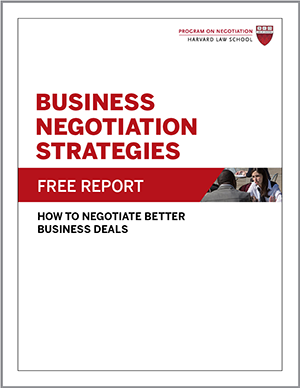
Those who effectively engage in a mutual-gains approach to negotiation, a bargaining scenario in which parties work together to meet interests and maximize value creation, can be stymied by the task of dividing up a seemingly fixed pie of resources, such as budgets, revenue, and time. Tough distributive negotiations, or value-claiming negotiations, can poison negotiations and destroy business partnerships. What is the best way to ensure win-win solutions at the bargaining table?
The Mutual Gains Approach at the Negotiation Table: Integrative Negotiations and the Negotiation Process
In negotiation, figuring out who should get what is rarely easy, but creative solutions to problems in negotiation do exist. Consider the legendary “Malice in Dallas.” Back in 1990, Stevens Aviation, a South Carolina–based aviation sales and maintenance company, began using the advertising slogan “Plane Smart.” In 1991, Southwest Airlines coined the phrase “Just Plane Smart,” and Stevens notified Southwest of the apparent trademark infringement.
The dispute easily could have cost both sides hundreds of thousands of dollars in legal fees. Instead of bringing in the lawyers, however, Stevens chairman Kurt Herwald came up with a novel approach to resolving the conflict: he challenged Southwest CEO Herb Kelleher to an arm-wrestling match. Whoever won the best of three would earn rights to the slogan, and the loser of each match would make a donation to a charity of the winner’s choice. Kelleher accepted.
Examples of Negotiation in Real Life – “Malice in Dallas”
On March 20, 1992, several thousand people attended the “Malice in Dallas” at Dallas’s Sportatorium. The event was widely covered by the national media. Stevens’s Herwald won two of the three matches and the right to the slogan.
Shortly after winning, Herwald agreed to let Southwest continue to use its slogan. The companies presented $10,000 to the Muscular Dystrophy Association and $5,000 to the Cleveland Ronald McDonald House. Then-president George H.W. Bush commended them on their win-win solutions.
Ed Stewart, Southwest’s manager of public relations, estimates that the match saved his company $500,000 in legal fees and generated $6 million in publicity. As for Stevens Aviation, Herwald partially credits the event for his company’s three-year increase in business, from $28 million to more than $100 million.
The upshot: Approaching distributive negotiations (haggling or value-claiming negotiations) with a creative mindset will not only preserve a relationship but also add significant value for both sides creating win-win solutions.
Related Business Negotiations Article: How to Avoid a Bidding War – A bidding war can be an unpleasant process for business negotiators seeking a negotiated agreement with their counterpart. In essence, a bidding war involves each side outbidding the other until one side can no longer go any further in the process and thus, by default, the highest bidder takes the prize – an excellent situation for a seller, to be sure. Can negotiators head off a bidding war and thus save time and money? What value creation opportunities exist in such a bargaining scenario? In this article bargaining skills, the advice is given for heading off bidding wars at the bargaining table in business negotiations and elsewhere.
Integrative Negotiations Strategies and Negotiation Ethics: Social Proof and Acceptable Behavior – What social cues do bargainers give one another at the negotiation table and how can expert negotiators incorporate these visual markers in their negotiation style? Being able to effectively read your counterpart during negotiations can lead to opportunities for value creation, and claiming, that would be missed by less perceptive negotiators. In this article, the negotiation research around social cues and how norms of acceptable behavior impact bargainers explicitly, and implicitly, in a variety of negotiation scenarios from business negotiations and sales negotiations to interpersonal negotiations.
Do you have a foolproof method for getting win-win solutions in your negotiations? Share your tips in the comments.
Adapted from “Divide the Pie—Without Antagonizing the Other Side,” by Robert C. Bordone, first published in the November 2006 Negotiation newsletter.
Originally posted in 2011.






No Responses to “Coming Up with Win-Win Solutions at the Bargaining Table”